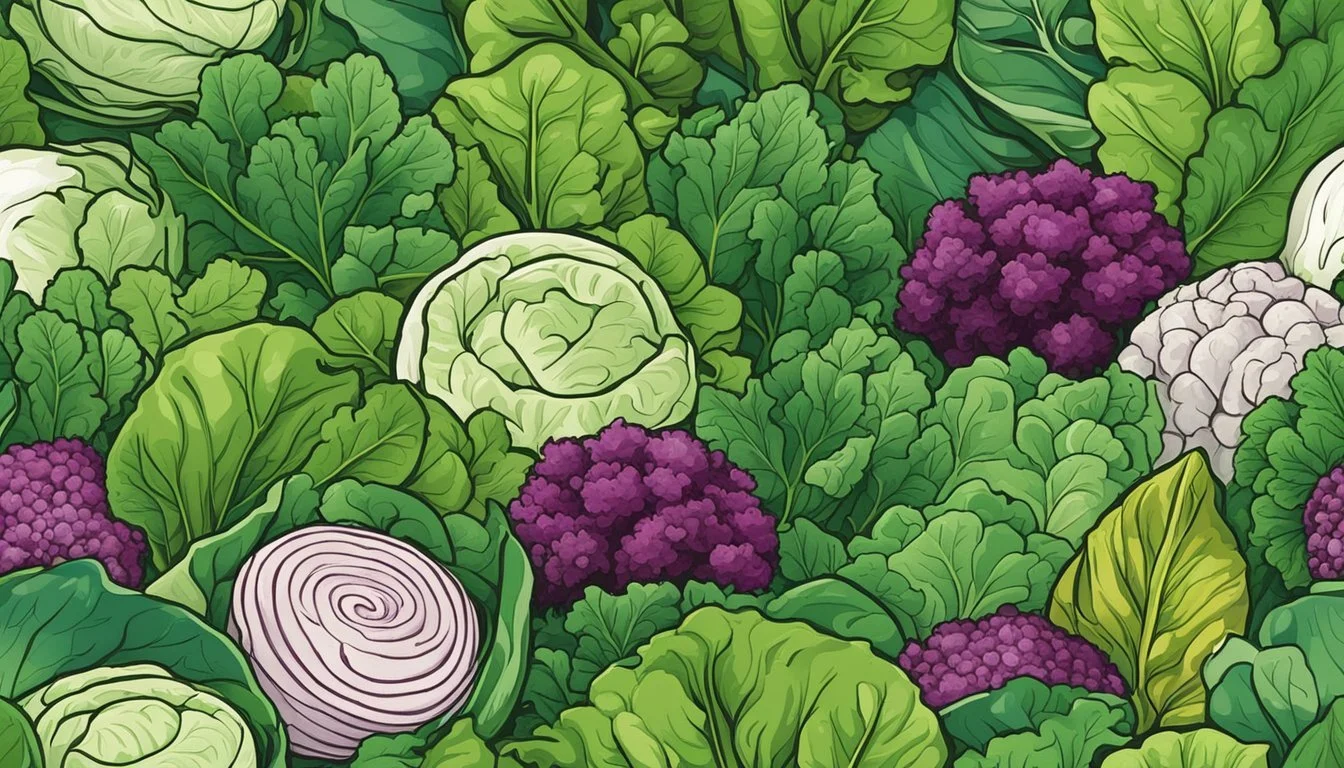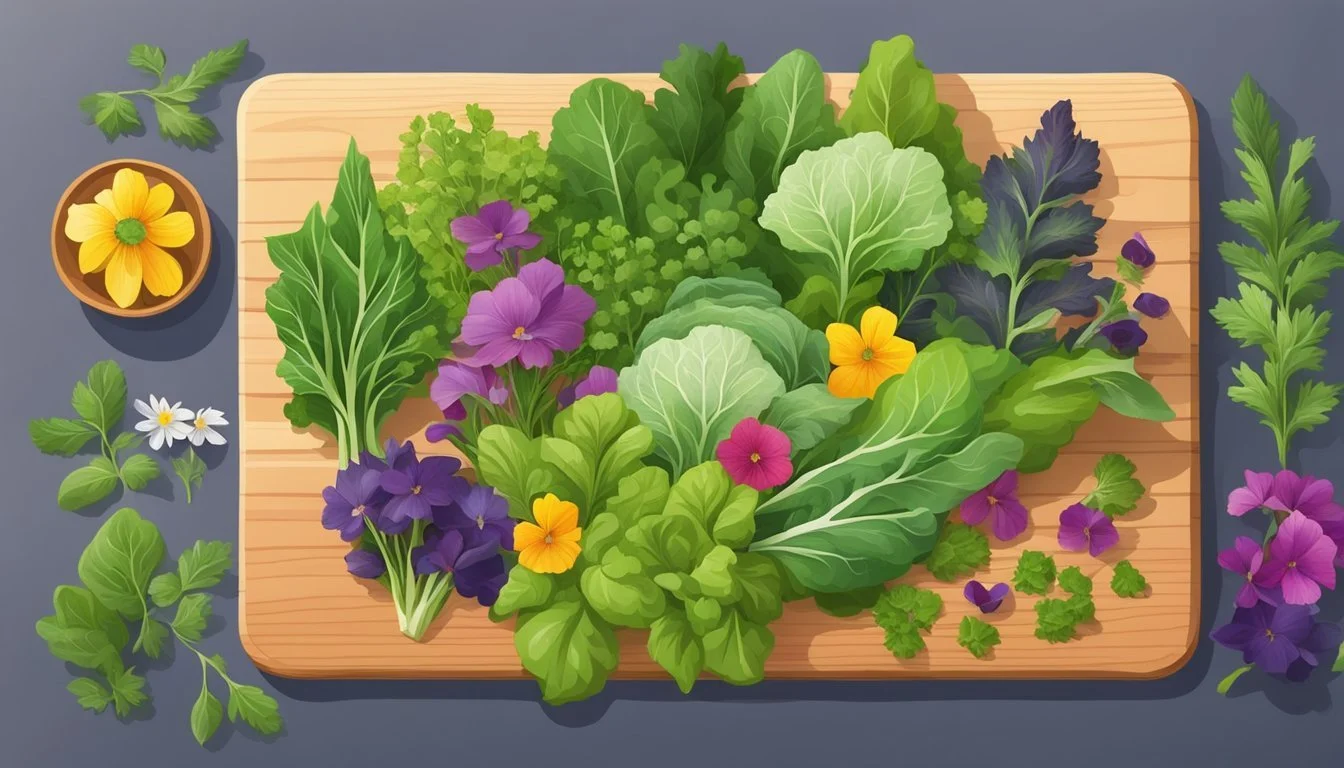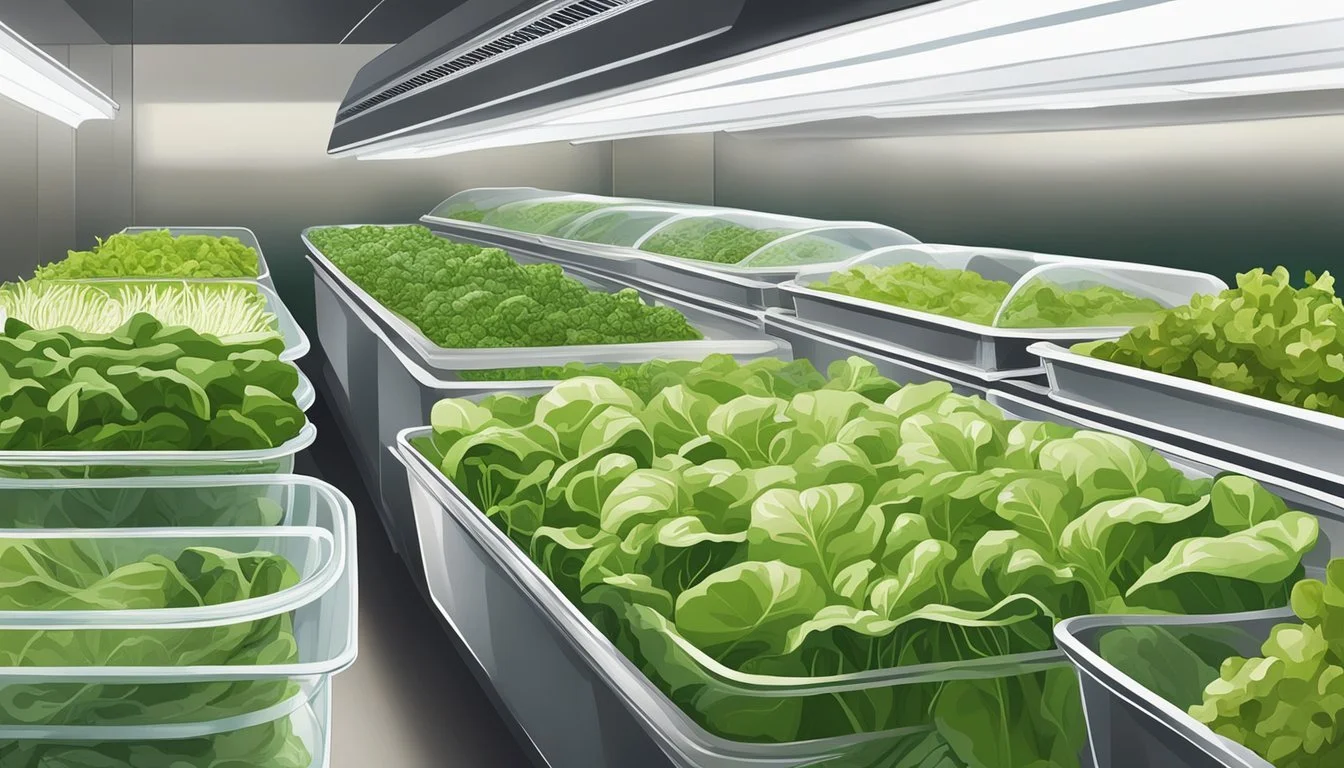Mesclun Substitutes
Top Alternatives for Your Salad Mix
Mesclun is a term derived from the French word for "mixture," and traditionally refers to a salad blend of young, tender greens. It often includes a diverse array of leafy varieties such as arugula, chervil, endive, frisée, radicchio, and oak leaf lettuce. This medley not only delivers a mosaic of flavors ranging from peppery to slightly bitter but also provides an assortment of textures, making mesclun a sought-after salad base. The nutritional profile of mesclun is just as varied as its composition, supplying a wealth of vitamins and minerals beneficial to health.
Despite its popularity, there are times when mesclun might not be readily available, or one might seek alternatives for reasons of taste, texture, or nutritional content. In such cases, finding appropriate substitutes for mesclun involves considering greens that offer similar taste profiles and textures to match the unique characteristics of the original mix. For the slightly peppery zest one might miss from arugula, watercress or baby spinach can serve as suitable replacements. Other leafy vegetables like kale, Swiss chard, or mixed baby lettuces can mimic the textural variety that mesclun provides.
In creating a substitute for a mesclun salad blend, it is essential to balance the flavors and textures to achieve a harmonious mix. While no single green can replicate the complex profile of mesclun, a thoughtfully combined selection of alternative greens can yield a salad that resonates with the same spirit of variety and enjoyment. Such alternatives allow salad lovers to continue enjoying fresh, flavorful, and nutritious greens in their meals.
Understanding Mesclun
Mesclun plays a fundamental role in salads by offering a diverse range of flavors and textures. It is both nutritionally rich and varied in its composition.
Origin and Definition
Mesclun originated in Provence, France, as a traditional salad mix. It typically refers to a blend of young, tender salad leaves, freshly harvested before they reach full size. The term "mesclun" itself is from the French language, meaning a mixture of several types of salad greens.
Common Varieties
The varieties of greens in a mesclun mix can vary, but the blend often includes:
Leaf lettuce: A staple for its mild taste and tender texture.
Arugula: Noted for its peppery flavor, adding a spicy note to the mix.
Endive and radicchio: Both offering a subtle bitterness.
Chervil: Contributes a hint of anise.
Mâche or lamb's lettuce: Brings a nutty flavor profile.
Other possible additions: Mizuna, frisée, and tatsoi, each contributing their own unique taste and texture.
Flavor and Texture Profiles
The flavor profile of mesclun is a symphony of tastes ranging from mild and nutty to peppery and slightly bitter. The texture is a blend of tender, soft leaves with some varieties contributing a delicate crunch. This balance of flavors and textures culminates in a salad that is both complex and harmonious.
Nutritional Value
Mesclun greens are not only flavorful but also nutritionally beneficial. They commonly contain:
Vitamins: Such as vitamin A, C, and K.
Minerals: Including iron and calcium.
Fiber: Aids in digestion.
Eating a variety of mesclun greens contributes to a well-rounded intake of these essential nutrients, promoting overall health.
Selecting Quality Mesclun
When choosing mesclun, one should consider the freshness of the greens and the variety included in the mix. These factors are crucial for both flavor and nutritional value.
Freshness Indicators
One can identify fresh mesclun by its bright color and crisp texture. The leaves should appear vibrant and free from wilting or yellowing. At a grocery store or farm, the mesclun greens should be stored in a cool environment, as this helps maintain their freshness. A simple touch test can reveal much about the leafy greens' condition; they should feel firm and spring back when lightly pressed.
Variety Selection
Selecting mesclun with a diverse range of leafy greens can enhance both the flavor profile and the nutritional content of dishes. A quality mix often includes:
Leaf Lettuce: Look for mixes with both red and green varieties.
Arugula: Sought after for its peppery flavor.
Endive and Radicchio: Add a pleasant bitterness.
A mix may also feature specialty greens such as chervil or mâche. Ensure the variety complements the intended meal, keeping in mind that some greens pair better with certain dressings or ingredients than others.
Mesclun in Culinary Uses
Mesclun, with its diverse blend of young, tender greens, offers a versatile base for a variety of culinary creations, specifically in salads, where its flavors can be enhanced with compatible ingredients and dressings.
Salad Preparation
When preparing a salad with mesclun, chefs typically look for the freshest mix possible, often found in the produce aisle or at a farmer's market. The delicate leaves of mesclun are best when lightly tossed rather than overworked to maintain their texture. A basic mesclun salad may include:
Leaf lettuce: For a soft, buttery texture.
Arugula: Adding a peppery note.
Endive and radicchio: Contributing a mild bitterness.
Complementary Ingredients
Mesclun pairs well with a wide range of ingredients that can complement or contrast its flavors. Common additions include:
Nuts: Such as slivered almonds or walnuts for a crunchy texture.
Fruits: Sliced strawberries or apples for a sweet contrast.
Cheese: Goat cheese or shaved Parmesan for a note of richness.
Dressing Pairings
The dressing chosen for mesclun should enhance its natural flavors without overwhelming them. Light dressings are preferable. Here are some popular combinations:
Olive oil and lemon juice: A simple classic that brightens the greens.
Balsamic vinaigrette: Offers a balance of sweetness and acidity.
Herb-infused dressings: Such as those with chervil or dill that bring out the herbaceous qualities of the salad mix.
Mesclun Substitutes
When a recipe calls for mesclun, one can find suitable alternatives that match the flavor profile and texture of this leafy blend. Here are options across different categories:
Leafy Green Alternatives
Lettuce: For a mild taste, one may use various types of lettuce as a stand-in. Romaine and butterhead lettuce provide a similar crunch and delicacy.
Spinach: A common alternative, spinach offers a slightly earthier flavor and is nutritionally dense.
Chard: Chard can replace mesclun for a slightly bitter note in salads.
Kale: A heartier texture and stronger taste but an acceptable substitute for the cooler months.
Herb Substitutions
Arugula: To mimic mesclun's peppery aspect, one might use arugula alone or mix it with milder greens.
Non-leafy Substitutes
For an unconventional twist, one might consider:
Microgreens: A collection of microgreens can provide a diverse flavor and visual appeal similar to mesclun.
Edible flowers: While not leafy, adding edible flowers can introduce a burst of color with a mild, vegetal flavor.
Maintaining and Storing Mesclun
Proper maintenance and storage of mesclun are critical for extending its shelf life and ensuring food safety. These guidelines focus on the optimal handling and storage techniques.
Proper Handling
When dealing with mesclun, it’s essential to handle the leaves gently to avoid bruising. They should be washed in cold water to remove any dirt or pests. After washing, mesclun should be dried thoroughly to prevent spoilage. A salad spinner can be effective in removing excess moisture. Once dried, mesclun must be handled with care, as rough treatment can damage the delicate leaves.
Storage Techniques
To maximize the shelf life of mesclun, it should be placed in a storage container that permits adequate air circulation. Here are specific steps for optimal storage:
Line a container with paper towels: These will absorb excess moisture, which can hasten decay.
Layer the mesclun gently on top: Ensure the leaves are loosely packed to avoid compression damage.
Cover with another paper towel: This will trap any residual moisture without suffocating the leaves.
Seal the container: The lid should be tight-fitting, but not airtight, to allow for some air exchange.
Refrigerate: Keep the container in the crisper drawer of the refrigerator.
Typically, properly stored mesclun can maintain quality for about 3 to 5 days. It is important not to wash mesclun before storage unless it is dried efficiently, as excess water can reduce storage time and contribute to bacterial growth, impacting food safety.
Health and Dietary Considerations
When considering Mesclun as part of a dietary plan, it's important to address the potential for allergies and sensitivities, as well as to understand the nutritional benefits this mix of greens provides. Mesclun consists of various leafy vegetables, each bringing its own set of minerals and vitamins that are essential for a healthy diet.
Allergies and Sensitivities
Mesclun is generally safe for most individuals; however, it contains a variety of greens which means a range of potential allergens. Individuals with sensitivities to certain plants may need to carefully review the mix's components. Cruciferous vegetables can sometimes cause issues for those with thyroid conditions, and there may be a need to identify and remove particular greens from the mix that could exacerbate such sensitivities.
Dietary Benefits
The diverse composition of Mesclun greens makes them a powerful addition to a healthy diet. Here are some specific benefits:
Fiber: A serving of mesclun provides valuable fiber that aids in digestion.
Vitamins and Minerals: Mesclun contains vitamins A and C, calcium, and iron, which contribute to bone health, immune function, and overall wellbeing.
Low in Calories: With minimal carbohydrates and fat, mesclun is a low-calorie option that can assist in weight management.
To further illustrate the dietary benefits, here's a brief comparison in a table format showcasing the nutrients found in a 1-cup serving of mesclun greens and romaine lettuce, which is often substituted for mesclun:
Nutrient Mesclun (per 1 cup) Romaine Lettuce (per 1 cup) Carbohydrates 2 grams 2 grams Fiber 1 gram 1 gram Protein 1 gram 0.6 grams Vitamins/Minerals Vitamins A and C, calcium, iron Vitamins A and C, calcium, iron
The comparison shows mesclun as a nutrient-dense choice, providing a mix of essential nutrients while aligning with various dietary needs and preferences.
Shopping and Sourcing Tips
When shopping for mesclun substitutes, it is essential to look for freshness and quality. Consumers should seek out local produce where possible, as this often guarantees greater freshness and supports local farmers.
In the Grocery Store:
Look for bright, vibrant leaves with no signs of wilting or browning.
Organic options may offer less exposure to pesticides.
Check the "packed on" or "sell by" dates; the fresher, the better.
At the Farm or Market:
Engage with vendors and ask about the source of their greens.
Inquire if the greens are harvested the same day which often provides the best flavor and texture.
Market Tips:
Early morning visits often yield the best selection.
Bring a cooler or insulated bag to keep greens fresh on the return trip.
Local Produce:
Seek out farmers' markets for seasonal and locally-sourced mesclun mixes.
Joining a Community Supported Agriculture (CSA) program can provide regular supplies of fresh, locally grown greens.
Storage:
Upon purchasing, store mesclun or its substitutes in a humid and cool environment inside the refrigerator, loosely packed in a plastic bag or container with a paper towel to absorb excess moisture.
Freshness Indicators Description Color Rich, consistent coloring without yellow or dark spots. Texture Leaves should be crisp and spring back when touched. Smell A fresh, earthy smell indicates a recently harvested batch.
Remember, the delicate nature of mesclun greens and their substitutes dictate a short shelf life, and they are best enjoyed promptly after purchase.
Mesclun-Related Cuisine and Dishes
Mesclun, a blend of young, tender salad greens, is integral to various cuisines, offering a delicate balance of flavors and textures. It frequently appears in traditional and innovative dishes worldwide.
French Culinary Influence
Provence is the cradle of mesclun, where this mix of greens originated. In French cuisine, mesclun often forms the base of the renowned Salade Niçoise, a dish that combines vegetables, such as tomatoes and green beans, with tuna, hard-boiled eggs, Niçoise olives, and anchovies. (What wine goes well with anchovies?) French chefs have been known to curate their greens carefully, ensuring a balanced mix that complements the vinaigrettes and other salad components typically found in French bistros and cafés.
Global Salad Inspirations
Globally, mesclun finds its way into salads with a variety of dressings ranging from simple oils and vinegars to more complex, flavored options. It's a common sight in salad bars and casual dining restaurants, where diners can appreciate the variety offered by mesclun-based salads. In different regions, mesclun is adopted and adapted, such as in Asian cuisines that might add sesame seeds and soy-based dressings, enhancing the mesclun with regional flavors.
Fusion and Modern Takes
Chefs around the world have embraced mesclun, incorporating it into fusion dishes that meld aspects of different culinary traditions. As a versatile ingredient, it can be found in wraps, sandwiches, and as a bed for grilled meats or fish. Modern gastronomy also sees mesclun in more avant-garde dishes, where its freshness complements more intense or unusual flavors, such as those created with molecular gastronomy techniques.









